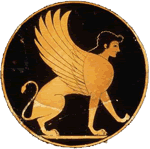1) the agon
Although appearing after plot and character in Aristotle's list of the parts of tragedy, as ranked in order of their importance, "thought" receives relatively little in the way of discussion in the Poetics. Instead, Aristotle refers his reader to his Rhetoric for a more extensive study of the art of making a forceful argument. The term Aristotle uses (διάνοια) clearly focuses on the process of persuasion through forceful speech. Aristotle speaks of the inclusion of thought in drama as follows:
![]()
This is what he refers to as the statesman's and the rhetorician's art. The "thought," or forceful expression of ideas, is largely included in the parts of a tragedy that are reserved for straight dialogue and are assigned the cadenced rhythms of iambic hexameter verse. Frequently, they rapidly resolve into the dialectic mode of stichomythia with assertions and rejoinders rapidly following one another with the rhythm of two boxers sparring. While the emphasis in Aristotle's consideration of effective debate is on expressing logical arguments and proofs, he also keeps his interest in the dramatic mode at the forefront.

The second and third of the above subdivisions are largely dramatic in nature. While Aristotle places effective reasoning in the first subdivision, the latter two concentrate on militating the audience's emotional responses effectively and on what he refers to as appreciating or deprecating an argument. The emphasis on eliciting emotional responses - "pity, fear, anger, and the like" - is consistent with his mode of ranking the possible plot situations. Predictably, Aristotle places his highest emphasis on those situations that are likely to elicit the greatest emotional response from the audience. He also argues that, while it is important to create clear rational arguments, the ability to put them in a context that will convince an audience of their value is equally important. Effectively, Aristotle applauds dramatists who not only present clear arguments and issues, but dramatize them as well.
A set section of several Greek tragedies was reserved for the conflict of ideas or a debate. The agon (ἀγών) usually sat at the philosophical center of the drama, and had a little bit of the compelling personality of a sporting event to it. The arguments contained in the agon were often witty and barbed so that they could land upon their opponents with added sting like sharp punches . They fell in rapid stichomythia, and the opponents met each thrust with a parry, and each insinuation with a rejoinder. Most frequently, the contenders (Prometheus and Hermes or Pentheus and Dionysus, for example) were at the heart of the drama, and the issues or positions debated were also at the heart of the drama. Friedrich Nietzsche's The Birth of Tragdey provides an excellent example in its development of the conflict central to The Bacchae. What we can observe from Nietzsche's work is that the issues and positions in conflict in the agon are expansive, and the action of several Greek tragedies seems to crystallize around the arguments at their core. Furthermore, the drama is all the more engaging if the positions argued in the agon appear evenly matched, and if the members of the audience would be hard pressed to say which one is better than the other. While Aristotle reserves the agon for the "thought" section in the Poetics, it can also be conceived of as a part of the plot. If the plot is a sequence of events, the agon is one of those events, and its place is at or near the conceptual center of the sequence. It debates the themes, ideas and issues that reverberate throughout the entire drama.
